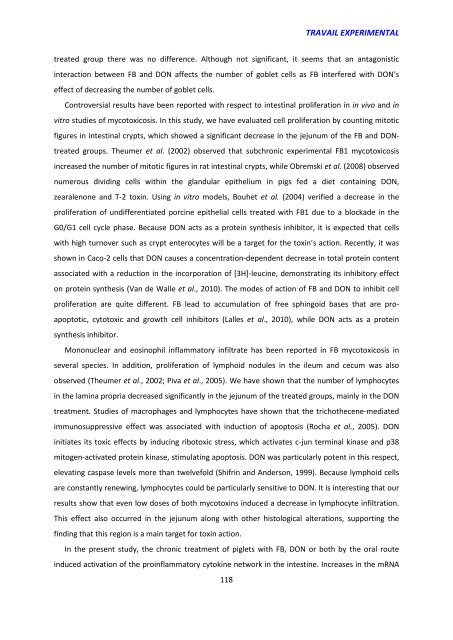Effet chez le porcelet d'une exposition à un régime co-contaminé en ...
Effet chez le porcelet d'une exposition à un régime co-contaminé en ...
Effet chez le porcelet d'une exposition à un régime co-contaminé en ...
Create successful ePaper yourself
Turn your PDF publications into a flip-book with our unique Google optimized e-Paper software.
TRAVAIL EXPERIMENTALtreated group there was no differ<strong>en</strong>ce. Although not significant, it seems that an antagonisticinteraction betwe<strong>en</strong> FB and DON affects the number of gob<strong>le</strong>t cells as FB interfered with DON’seffect of decreasing the number of gob<strong>le</strong>t cells.Controversial results have be<strong>en</strong> reported with respect to intestinal proliferation in in vivo and invitro studies of my<strong>co</strong>toxi<strong>co</strong>sis. In this study, we have evaluated cell proliferation by <strong>co</strong><strong>un</strong>ting mitoticfigures in intestinal crypts, which showed a significant decrease in the jej<strong>un</strong>um of the FB and DONtreatedgroups. Theumer et al. (2002) observed that subchronic experim<strong>en</strong>tal FB1 my<strong>co</strong>toxi<strong>co</strong>sisincreased the number of mitotic figures in rat intestinal crypts, whi<strong>le</strong> Obremski et al. (2008) observednumerous dividing cells within the glandular epithelium in pigs fed a diet <strong>co</strong>ntaining DON,zeara<strong>le</strong>none and T-2 toxin. Using in vitro models, Bouhet et al. (2004) verified a decrease in theproliferation of <strong>un</strong>differ<strong>en</strong>tiated porcine epithelial cells treated with FB1 due to a blockade in theG0/G1 cell cyc<strong>le</strong> phase. Because DON acts as a protein synthesis inhibitor, it is expected that cellswith high turnover such as crypt <strong>en</strong>terocytes will be a target for the toxin’s action. Rec<strong>en</strong>tly, it wasshown in Ca<strong>co</strong>-2 cells that DON causes a <strong>co</strong>nc<strong>en</strong>tration-dep<strong>en</strong>d<strong>en</strong>t decrease in total protein <strong>co</strong>nt<strong>en</strong>tassociated with a reduction in the in<strong>co</strong>rporation of [3H]-<strong>le</strong>ucine, demonstrating its inhibitory effecton protein synthesis (Van de Wal<strong>le</strong> et al., 2010). The modes of action of FB and DON to inhibit cellproliferation are quite differ<strong>en</strong>t. FB <strong>le</strong>ad to accumulation of free sphingoid bases that are proapoptotic,cytotoxic and growth cell inhibitors (Lal<strong>le</strong>s et al., 2010), whi<strong>le</strong> DON acts as a proteinsynthesis inhibitor.Mononuc<strong>le</strong>ar and eosinophil inflammatory infiltrate has be<strong>en</strong> reported in FB my<strong>co</strong>toxi<strong>co</strong>sis inseveral species. In addition, proliferation of lymphoid nodu<strong>le</strong>s in the i<strong>le</strong>um and cecum was alsoobserved (Theumer et al., 2002; Piva et al., 2005). We have shown that the number of lymphocytesin the lamina propria decreased significantly in the jej<strong>un</strong>um of the treated groups, mainly in the DONtreatm<strong>en</strong>t. Studies of macrophages and lymphocytes have shown that the trichothec<strong>en</strong>e-mediatedimm<strong>un</strong>osuppressive effect was associated with induction of apoptosis (Rocha et al., 2005). DONinitiates its toxic effects by inducing ribotoxic stress, which activates c-j<strong>un</strong> terminal kinase and p38mitog<strong>en</strong>-activated protein kinase, stimulating apoptosis. DON was particularly pot<strong>en</strong>t in this respect,e<strong>le</strong>vating caspase <strong>le</strong>vels more than twelvefold (Shifrin and Anderson, 1999). Because lymphoid cellsare <strong>co</strong>nstantly r<strong>en</strong>ewing, lymphocytes <strong>co</strong>uld be particularly s<strong>en</strong>sitive to DON. It is interesting that ourresults show that ev<strong>en</strong> low doses of both my<strong>co</strong>toxins induced a decrease in lymphocyte infiltration.This effect also occurred in the jej<strong>un</strong>um along with other histological alterations, supporting thefinding that this region is a main target for toxin action.In the pres<strong>en</strong>t study, the chronic treatm<strong>en</strong>t of pig<strong>le</strong>ts with FB, DON or both by the oral routeinduced activation of the proinflammatory cytokine network in the intestine. Increases in the mRNA118

















